Ricoh Aficio SP C320DN Owner's Manual

Operating Instructions
Hardware Guide
1 Guide to the Printer
2 Setting Up the Printer
3Installing Options
4Connecting the Printer
5 Configuration
6Loading Paper
7 Maintaining the Printer
8 Adjusting the Printer
9Troubleshooting
10Removing Misfed Paper
11Appendix
Read this manual carefully before you use this machine and keep it handy for future reference. For safe and correct use, be sure to read "Safety Information" before using the machine.
Introduction
This manual contains detailed instructions and notes on the operation and use of this machine. For your safety and benefit, read this manual carefully before using the machine. Keep this manual in a handy place for quick reference.
Do not copy or print any item for which reproduction is prohibited by law. Copying or printing the following items is generally prohibited by local law:
bank notes, revenue stamps, bonds, stock certificates, bank drafts, checks, passports, driver's licenses.
The preceding list is meant as a guide only and is not inclusive. We assume no responsibility for its completeness or accuracy. If you have any questions concerning the legality of copying or printing certain items, consult with your legal advisor.
Important
Contents of this manual are subject to change without prior notice.
In no event will the company be liable for direct, indirect, special, incidental, or consequential damages as a result of handling or operating the machine.
For good print quality, the manufacturer recommends that you use genuine toner from the manufacturer.
The manufacturer shall not be responsible for any damage or expense that might result from the use of parts other than genuine parts from the manufacturer with your office products.
Some illustrations in this manual might be slightly different from the machine.
Certain options might not be available in some countries. For details, please contact your local dealer.

TABLE OF CONTENTS |
|
How to Read This Manual................................................................................................................................. |
6 |
Symbols........................................................................................................................................................... |
6 |
Model-Specific Information............................................................................................................................... |
7 |
Positions of WARNING and CAUTION Labels............................................................................................... |
8 |
Power Switch Symbols................................................................................................................................... |
9 |
Manuals for This Printer................................................................................................................................... |
10 |
List of Options................................................................................................................................................... |
11 |
Operating Instructions...................................................................................................................................... |
12 |
Reading the HTML Manuals on the CD-ROMs......................................................................................... |
12 |
Reading the HTML Manuals That You Install on the Computer............................................................... |
12 |
1. Guide to the Printer |
|
Exterior: Front View.......................................................................................................................................... |
15 |
Exterior: Rear View........................................................................................................................................... |
17 |
Interior............................................................................................................................................................... |
19 |
Control Panel.................................................................................................................................................... |
21 |
Display Panel.................................................................................................................................................... |
23 |
2. Setting Up the Printer |
|
Printer Setup Procedure................................................................................................................................... |
25 |
Place to Install................................................................................................................................................... |
26 |
Unpacking........................................................................................................................................................ |
30 |
Turning the Printer's Power On and Off.......................................................................................................... |
36 |
Turning on the Power................................................................................................................................... |
36 |
Turning off the Power................................................................................................................................... |
38 |
Selecting the Display Language...................................................................................................................... |
42 |
Test Printing....................................................................................................................................................... |
43 |
3. Installing Options |
|
Available Options............................................................................................................................................ |
45 |
Order of Option Installation........................................................................................................................ |
45 |
Where to Install Options............................................................................................................................. |
45 |
Attaching the Paper Feed Unit........................................................................................................................ |
48 |
Installing the Memory Expansion Units.......................................................................................................... |
51 |
Installing the SDRAM Module.................................................................................................................... |
51 |
Installing the Hard Disk................................................................................................................................ |
54 |
1
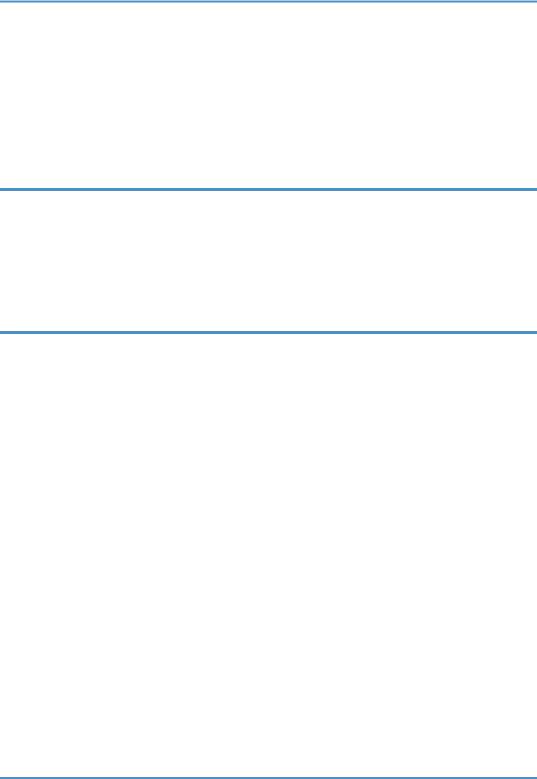
Installing the Interface Units............................................................................................................................. |
57 |
Installing the Gigabit Ethernet Board......................................................................................................... |
57 |
Installing the Wireless LAN Interface Board.............................................................................................. |
60 |
Installing the IEEE 1284 Interface Board................................................................................................... |
62 |
Installing the SD Memory Card Options........................................................................................................ |
65 |
4. Connecting the Printer |
|
Ethernet Cable Connection............................................................................................................................. |
69 |
Reading the LED Lamps............................................................................................................................... |
72 |
USB Cable Connection.................................................................................................................................... |
73 |
Digital Camera Connection........................................................................................................................ |
74 |
Parallel Cable Connection.............................................................................................................................. |
77 |
5. Configuration |
|
Ethernet Configuration..................................................................................................................................... |
79 |
Specifying an IP Address (No DHCP)........................................................................................................ |
80 |
Receiving an IP Address Automatically (DHCP)........................................................................................ |
82 |
Configuring Network Settings When Using NetWare............................................................................. |
84 |
Setting the Ethernet Speed.......................................................................................................................... |
85 |
Wireless LAN Configuration........................................................................................................................... |
88 |
Setting the SSID............................................................................................................................................ |
90 |
Confirming Wireless Network Connectivity............................................................................................... |
91 |
Cautions When Using a Wireless LAN...................................................................................................... |
92 |
Setting Security Method of Wireless LAN...................................................................................................... |
93 |
Setting a WEP Key....................................................................................................................................... |
93 |
Setting WPA................................................................................................................................................. |
94 |
Configuring IEEE 802.1X................................................................................................................................ |
98 |
Installing a Site Certificate........................................................................................................................... |
98 |
Installing Device Certificate......................................................................................................................... |
98 |
Enabling SSL................................................................................................................................................. |
99 |
Setting Items of IEEE 802.1X for Ethernet................................................................................................ |
100 |
Setting Items of IEEE 802.1X for Wireless LAN...................................................................................... |
102 |
6. Loading Paper |
|
Supported Paper for Each Tray.................................................................................................................... |
105 |
Symbols...................................................................................................................................................... |
105 |
2

Standard Paper Feed Tray....................................................................................................................... |
105 |
Optional Paper Feed Tray........................................................................................................................ |
106 |
Bypass Tray................................................................................................................................................ |
107 |
Supported Paper Types................................................................................................................................. |
108 |
Plain Paper................................................................................................................................................. |
108 |
Middle Thick.............................................................................................................................................. |
108 |
Thick Paper................................................................................................................................................. |
108 |
Thin Paper.................................................................................................................................................. |
109 |
Letterhead.................................................................................................................................................. |
110 |
Label Paper................................................................................................................................................ |
110 |
Coated Paper (Glossy)............................................................................................................................. |
110 |
Coated Paper (Glossy: Thick).................................................................................................................. |
110 |
Coated Paper (Matted)............................................................................................................................ |
111 |
Coated Paper (Matted: Thick).................................................................................................................. |
111 |
Special Paper............................................................................................................................................ |
112 |
Preprinted Paper........................................................................................................................................ |
112 |
Color Paper................................................................................................................................................ |
112 |
Recycled Paper.......................................................................................................................................... |
113 |
Cardstock................................................................................................................................................... |
113 |
Bond Paper................................................................................................................................................ |
113 |
Envelopes................................................................................................................................................... |
114 |
Storing Paper............................................................................................................................................. |
115 |
Non-Recommended Paper Types................................................................................................................ |
116 |
Print Area........................................................................................................................................................ |
117 |
Loading Paper in Trays.................................................................................................................................. |
119 |
Loading Paper into a Standard or Optional Paper Feed Tray.............................................................. |
119 |
Loading Paper onto Bypass Tray............................................................................................................. |
132 |
Loading Envelopes........................................................................................................................................ |
139 |
Loading Envelopes onto Bypass Tray...................................................................................................... |
139 |
Printing on Fixed-Orientation Paper............................................................................................................. |
143 |
Registering Unique Names to Paper Types................................................................................................. |
145 |
Registering Names to Paper Types.......................................................................................................... |
145 |
Setting User Paper Types to Trays............................................................................................................ |
145 |
3
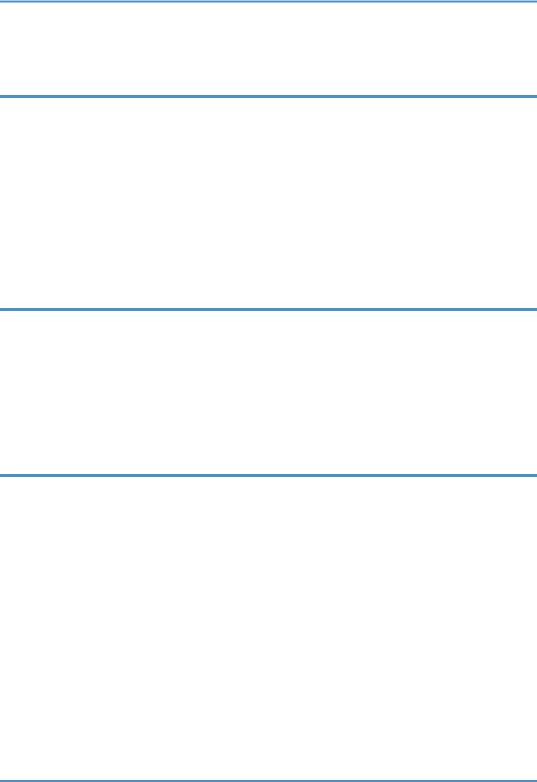
Printing Using Registered Paper Types.................................................................................................... |
146 |
7. Maintaining the Printer |
|
Replacing the Print Cartridge........................................................................................................................ |
147 |
Replacing the Waste Toner Bottle................................................................................................................ |
154 |
Replacing the Intermediate Transfer Unit..................................................................................................... |
161 |
Replacing the Maintenance Kit.................................................................................................................... |
172 |
Cautions When Cleaning.............................................................................................................................. |
179 |
Cleaning the Toner Density Sensor.............................................................................................................. |
180 |
Cleaning the Friction Pad and the Paper Feed Roller................................................................................. |
182 |
Cleaning the Registration Roller and the Paper Tray.................................................................................. |
185 |
8. Adjusting the Printer |
|
Adjusting the Color Registration................................................................................................................... |
189 |
Correcting the Color Gradation................................................................................................................... |
191 |
Setting the Gradation Correction Value.................................................................................................. |
191 |
Viewing the Gradation Correction Sheet................................................................................................ |
194 |
Resetting the Gradation Correction Value to the Initial Value............................................................... |
195 |
Adjusting Printing Position............................................................................................................................. |
197 |
9. Troubleshooting |
|
Error and Status Messages Appear on the Control Panel.......................................................................... |
201 |
Status Messages (in alphabetical order)................................................................................................. |
201 |
Alert Messages (in alphabetical order)................................................................................................... |
202 |
Panel Tones.................................................................................................................................................... |
208 |
Printer Does Not Print.................................................................................................................................... |
209 |
Checking the Port Connection.................................................................................................................. |
210 |
Other Printing Problems................................................................................................................................. |
212 |
When You Cannot Print Properly............................................................................................................. |
212 |
Paper Misfeeds Occur Frequently........................................................................................................... |
215 |
The printed image is different from the image on the computer............................................................ |
217 |
When Printer is Not Functioning Properly............................................................................................... |
219 |
Additional Troubleshooting........................................................................................................................... |
222 |
10. Removing Misfed Paper |
|
When Paper is Jammed................................................................................................................................. |
225 |
Paper Misfeed Message (A)......................................................................................................................... |
227 |
4
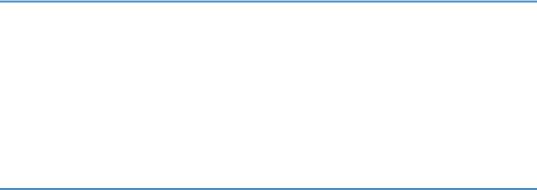
Misfeed Tray 1.......................................................................................................................................... |
227 |
Misfeed Bypass Tray................................................................................................................................. |
229 |
Paper Misfeed Message (B)......................................................................................................................... |
231 |
Paper Misfeed Message (Y)......................................................................................................................... |
234 |
Paper Misfeed Message (Z)......................................................................................................................... |
235 |
11. Appendix |
|
Moving and Transporting the Printer............................................................................................................ |
237 |
Moving the Printer in a Short Distance.................................................................................................... |
238 |
Consumables.................................................................................................................................................. |
239 |
Print Cartridge............................................................................................................................................ |
239 |
Waste Toner Bottle.................................................................................................................................... |
240 |
Intermediate Transfer Unit......................................................................................................................... |
240 |
Maintenance Kit........................................................................................................................................ |
241 |
Specifications................................................................................................................................................. |
242 |
Mainframe................................................................................................................................................. |
242 |
Options....................................................................................................................................................... |
245 |
Trademarks..................................................................................................................................................... |
249 |
INDEX........................................................................................................................................................... |
251 |
5
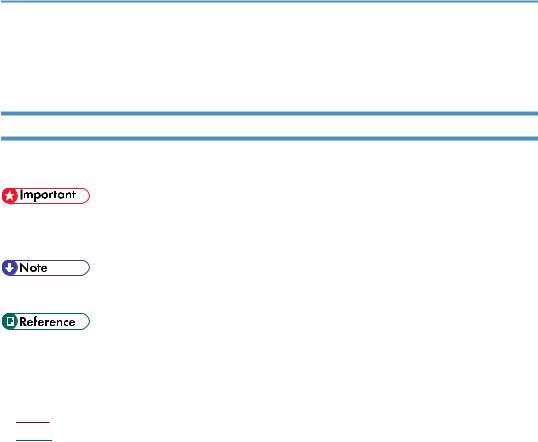
How to Read This Manual
Symbols
This manual uses the following symbols:
Indicates points to pay attention to when using the machine, and explanations of likely causes of paper misfeeds, damage to originals, or loss of data. Be sure to read these explanations.
Indicates supplementary explanations of the machine's functions, and instructions on resolving user errors.
This symbol is located at the end of sections. It indicates where you can find further relevant information.
[ ]
Indicates the names of keys on the machine's display or control panels.




 (mainly Europe and Asia)
(mainly Europe and Asia)




 (mainly North America)
(mainly North America)
Differences in the functions of Region A and Region B models are indicated by two symbols. Read the information indicated by the symbol that corresponds to the region of the model you are using. For details about which symbol corresponds to the model you are using, see "Model-Specific Information".
6
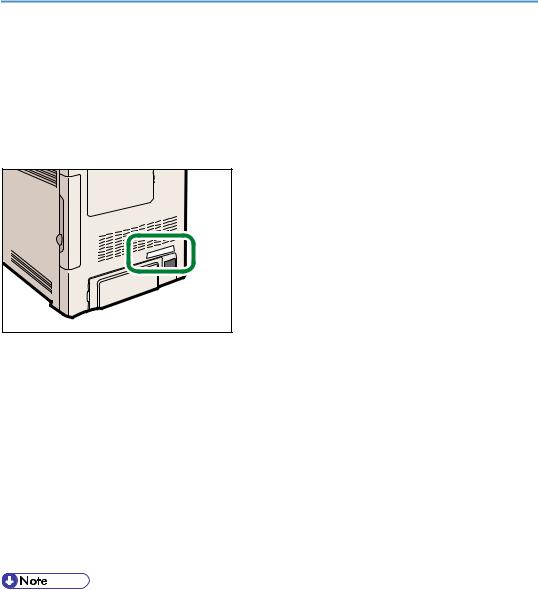
Model-Specific Information
This section explains how you can identify the region your machine belongs to.
There is a label on the rear of the machine, located in the position shown below. The label contains details that identify the region your machine belongs to. Read the label.
CBK001
The following information is region-specific. Read the information under the symbol that corresponds to the region of your machine.




 (mainly Europe and Asia)
(mainly Europe and Asia)
If the label contains the following, your machine is a region A model:
•CODE XXXX -22, -27
•220-240V




 (mainly North America)
(mainly North America)
If the label contains the following, your machine is a region B model:
•CODE XXXX -17, -51
•120 V
•Dimensions in this manual are given in two units of measure: metric and inch. If your machine is a Region A model, refer to the metric units. If your machine is a Region B model, refer to the inch units.
7
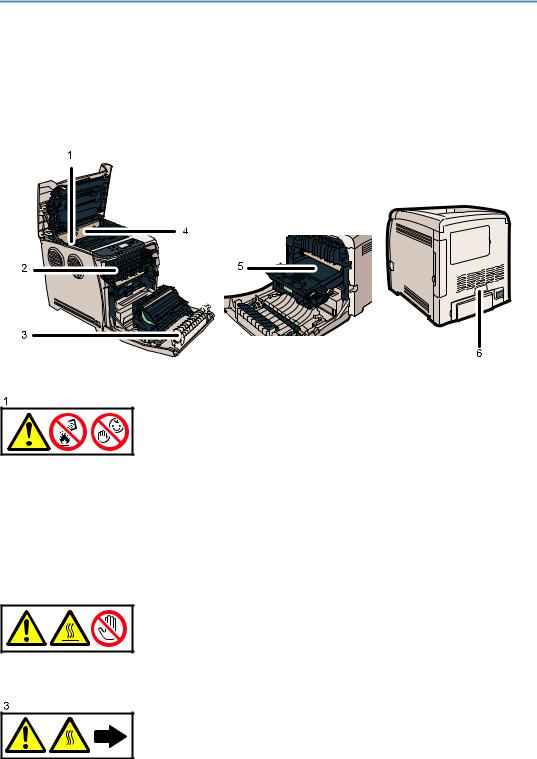
Positions of WARNING and CAUTION Labels
This machine has labels for  WARNING and
WARNING and  CAUTION at the positions shown below. For safety, please follow the instructions and handle the machine as indicated.
CAUTION at the positions shown below. For safety, please follow the instructions and handle the machine as indicated.
CBK002
CBK003
Do not incinerate spilled toner or used toner. Toner dust is flammable and might ignite when exposed to an open flame.
Disposal should take place at an authorized dealer or an appropriate collection site.
If you dispose of the used toner containers yourself, dispose of them according to local regulations. Keep toner (used or unused) and toner containers out of reach of children.
2
CBK004
The inside of this printer becomes very hot. Do not touch parts with this label (indicating a hot surface).
CBK007
The inside of this printer becomes very hot. Do not touch parts with this label (indicating a hot surface).
8
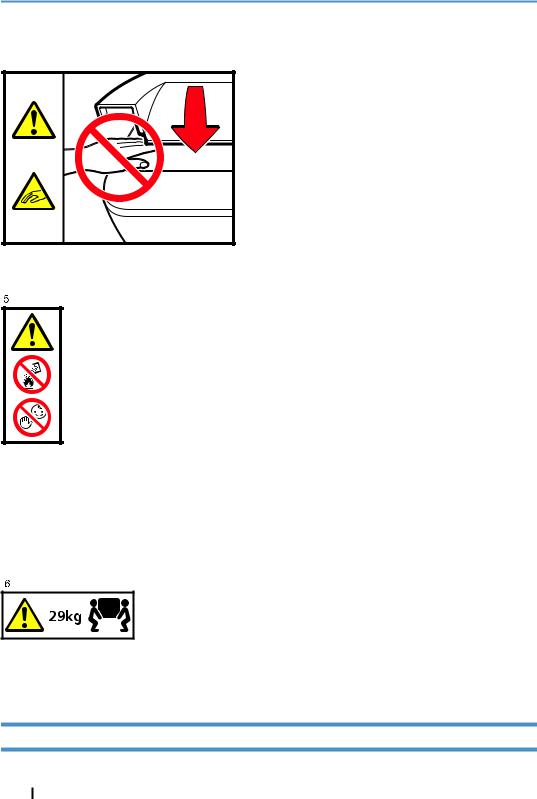
4 |
CBK008 |
Be careful not to trap your fingers when opening or closing the top cover.
CBK009
Do not incinerate spilled toner or used toner. Toner dust is flammable and might ignite when exposed to an open flame.
Disposal should take place at an authorized dealer or an appropriate collection site.
If you dispose of the used toner containers yourself, dispose of them according to local regulations. Keep toner (used or unused) and toner containers out of reach of children.
CBK010
The printer weighs approximately 29 kg (64.0 lb.). When moving the printer, use the inset grips on both sides, and lift slowly in pairs.
Power Switch Symbols
The meanings of the symbols for the switches on this machine are as follows:
•: POWER ON
• : POWER OFF
: POWER OFF
9

Manuals for This Printer
Read this manual carefully before you use this printer.
Refer to the manuals that are relevant to what you want to do with the printer.
•Media differ according to manual.
•The printed and electronic versions of a manual have the same contents.
•Adobe Acrobat Reader/Adobe Reader must be installed in order to view the manuals as PDF files.
•A Web browser must be installed in order to view the html manuals.
Safety Information
Contains information about safe usage of this printer.
To avoid injury and prevent damage to the printer, be sure to read this.
Quick Installation Guide
Contains procedures for removing the printer from its box, and connecting it to a computer.
Hardware Guide (This manual)
Contains information about paper; names and functions of the parts of this printer; and procedures such as installing options, replacing consumables, responding to error messages, and resolving jams.
Driver Installation Guide
Contains procedures for installing the printer driver. This manual is included on the driver CD-ROM.
Software Guide
Contains information about using this printer, its software, and its security functions.
Security Guide
This manual is for administrators of the printer. It explains security functions that you can use to prevent unauthorized use of the printer, data tampering, or information leakage. Be sure to read this manual when setting the enhanced security functions, or user and administrator authentication.
VM Card Extended Feature Settings Web Reference
Contains information about setting up the extended features settings using Web Image Monitor.
UNIX Supplement
Contains information about the usage of commands to operate this printer.
To obtain the "UNIX Supplement", visit our Web site or consult an authorized dealer.
This manual includes explanations of functions and settings that might not be available on this printer. This manual is provided in English only.
10

List of Options
This section provides a list of options for this printer, and how they are referred to as in this manual.
Option List Referred to as
Paper Feed Unit TK1010
Hard Disk Drive Option Type C320
Memory Unit Type G 256 MB
Memory Unit Type I 512 MB
Gigabit Ethernet Board Type A
IEEE 802.11a/g Interface Unit Type L
IEEE 802.11a/g Interface Unit Type M
IEEE 1284 Interface Board Type A
Camera Direct Print Card Type H
Data Overwrite Security Unit Type L
HDD Encryption Unit Type D
SD Card for NetWare Printing Type F
VM CARD Type O
•For details about the specifications of each option, see "Specifications".
•p.242 "Specifications"
11

Operating Instructions
This section explains how to use HTML format manuals.
Reading the HTML Manuals on the CD-ROMs
This section describes how to read the HTML manuals on the supplied manual CD-ROMs.
1.Insert the CD-ROM into the CD-ROM drive of your computer.
2.Select a language and a product, and then click [OK].
3.Click [Read HTML manuals].
4.Click the title of manual you want to read.
The browser opens, and then the manual appears.
•The browsers we recommend are Internet Explorer 6 or later, Firefox 3.5 or later, and Safari 4.0 or later.
•Non-recommended browsers can display the simplified manual only.
•If you are using an earlier or non-recommended browser and the simplified version of the documentation does not appear automatically, open index.htm, which can be found in the following folder on the CD-ROM: MANUAL_HTML\LANG\(language)\(manual)\unv
•Depending on your computer's operating environments, you can select the HTML manual from the following two versions:
•Standard version
•Simplified version
•If you want to read the HTML manuals on a Macintosh, insert the CD-ROM into the CD-ROM drive, and then click [Read HTML manuals].
•If JavaScript is disabled or unavailable in your browser, you will not be able to search or use certain buttons in the HTML documentation.
Reading the HTML Manuals That You Install on the Computer
This section describes how to install and read the HTML manuals on your computer. For easy access, we recommend you install the manuals on your computer.
1.Insert the CD-ROM into the CD-ROM drive of your computer.
2.Select a language and a product, and then click [OK].
3.Click [Install manuals].
12
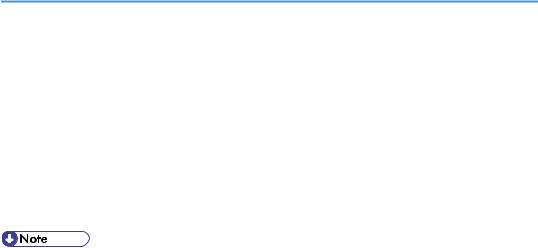
4.Install the HTML manuals following the on-screen instructions.
5.When the installation is complete, click [Finish].
6.Click [Exit].
7.Open the HTML manuals that you installed.
When opening the manuals from an icon, double-click the manual icon on the desktop. When opening the manuals from the [Start] menu, point to [All Programs] (Windows 2000: [Programs]), and then [Product Name].
8.Click the title of the manual you want to read.
•You need administrator permissions to install the manuals. Log in as an Administrators group member.
•The system requirements for installing the manuals are as follows:
•Operating system: Windows 2000/XP/Vista/7, Windows Server 2003/2003 R2/2008/2008 R2
•Minimum display resolution: 800 × 600 pixels
•If you cannot install a manual, copy the "MANUAL_HTML" folder to your computer's hard drive, and then run "Setup.exe".
•To delete an installed manual, on the [Start] menu, click [All Programs] (Windows 2000: [Programs]), then [Product Name], and then uninstall the data.
•Depending on the settings made during installation, menu folder names may differ.
13

14
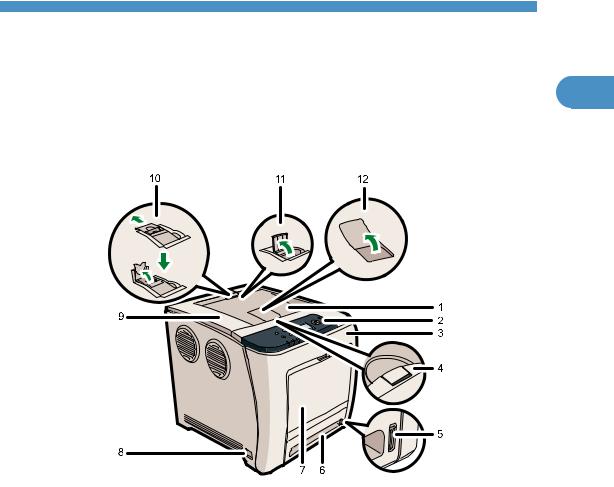
1. Guide to the Printer
This chapter explains the names and functions of the printer's components.
Exterior: Front View |
1 |
|
This section introduces the names and functions of the parts on the front and left sides of the printer.
CBK012
1.Standard Tray
Output is stacked here with the print side down.
2.Control Panel
Contains keys for printer control and a display that shows the printer status.
3.Front Cover
Open this cover to when replacing the waste toner bottle etc. or removing jammed paper. Pull the right side lever to open the front cover.
4.Top Cover Open Lever
Pull this lever upward to open the top cover.
5.Remaining Paper Indicator
Indicates the approximate amount of paper remaining in the tray.
6.Standard Paper Feed Tray (Tray 1)
Up to 500 sheets of plain paper can be loaded.
15
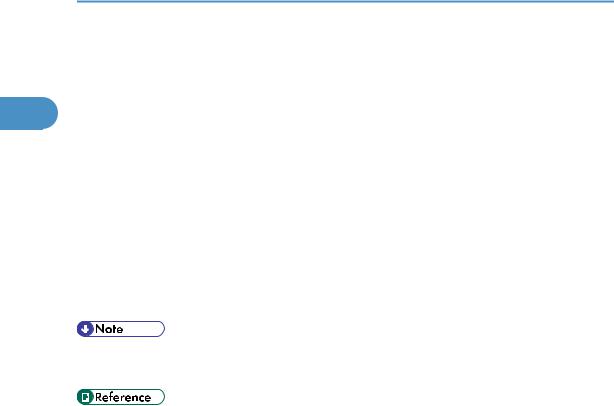
1.Guide to the Printer
7.Bypass Tray
Up to 100 sheets of plain paper can be loaded.
8.Power Switch
1Use this switch to turn the power on and off.
9.Top Cover
Open this cover to replace the print cartridge.
10.Stop Fence (Legal-size prints)
Raise the rear fence (by pulling it in the direction of the arrow) to stop Legal-size prints falling behind the printer.
11.Stop Fence (A4/Letter-size prints)
Raise the front fence to stop A4/Lettersize prints falling behind the printer.
12.Standard Tray Extension
Use this to support sheets that come out curled after they are printed.
Flip open the extension by pushing down on the end that is toward the rear of the printer.
•For details about the messages which appear on the screen to prompt you to replace the units, see "Error and Status Messages Appear on the Control Panel".
•p.201 "Error and Status Messages Appear on the Control Panel"
16
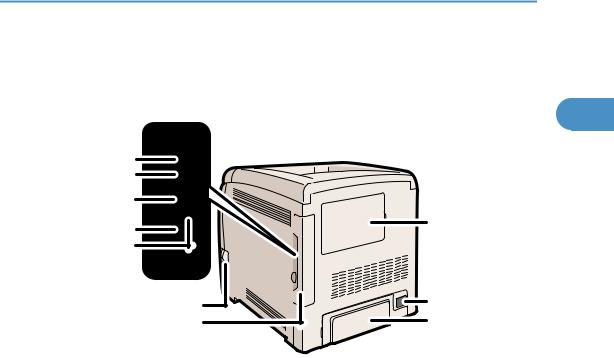
Exterior: Rear View
Exterior: Rear View
This section introduces the names and functions of the parts on the rear and right sides of the printer.
1
10 |
|
9 |
|
8 |
|
7 |
1 |
|
|
6 |
|
5 |
2 |
|
|
4 |
3 |
|
CBK013 |
1.Memory Cover
Remove this cover to install the additional SDRAM module and hard disk (optional).
2.Power Connector
Connect the power cord to the printer here. Insert the other end of the cable into a nearby wall outlet.
3.Rear Cover
Remove this cover when you load paper larger than A4 in the paper tray.
4.Cable Cover
Remove this cover to install the optional interface units and the SD card, and to connect various cables.
5.Front Cover Open Lever
Pull this lever to open the front cover.
6.Optional Interface Board Slot
Insert an optional Wireless LAN interface unit, Gigabit Ethernet board, or IEEE 1284 interface board in this slot.
7.USB Port A
Use a USB cable to connect the printer to a digital camera.
8.SD Card Slots
Remove the cover and install SD cards here. Install the data overwrite security unit, NetWare card or camera direct print card in the upper slot. Install the VM card or HDD encryption unit in the lower slot.
9.USB Port B
Use a USB cable to connect the printer to a computer.
10.Ethernet Port
Use a network interface cable to connect the printer to the network.
17

1.Guide to the Printer
•For details about the messages which appear on the screen to prompt you to replace the units, see "Error and Status Messages Appear on the Control Panel".
1




•p.201 "Error and Status Messages Appear on the Control Panel"
18

Interior
Interior
This section introduces the names and functions of the parts inside of the printer.
1
2
1
6 5
2
3
4
CBK014
1.Print Cartridge
Loads from the printer rear, in the order of cyan (C), magenta (M), yellow (Y), and black (K). If the following message appears on the control panel, replace the print cartridge:
•"Replcmnt Requrd: Print Cart"
2.Fusing Unit
If the following message appears on the control panel, replace the fusing unit:
•"Replacmnt Rqrd:Fusing Unit"
3.Transcription Roller
If the following message appears on the control panel, replace the transcription roller, which is included with the fusing unit:
•"Replacmnt Rqrd:Fusing Unit"
4.Paper Transfer Unit
Remove this unit when replacing the waste toner bottle, intermediate transfer unit.
5.Waste Toner Bottle
Collects toner that is wasted during printing.
If the message which prompts you to replace it appears on the display, replace the waste toner bottle.
•"Waste Toner Bottle full"
6.Intermediate Transfer Unit
If the following message appears on the control panel, replace the intermediate transfer unit:
19

1.Guide to the Printer
•"Replacemnt Requird:IntTrans"
•For details about the messages which appear on the screen to prompt you to replace the units, see
1"Error and Status Messages Appears on the Control Panel".
•p.201 "Error and Status Messages Appear on the Control Panel"
20
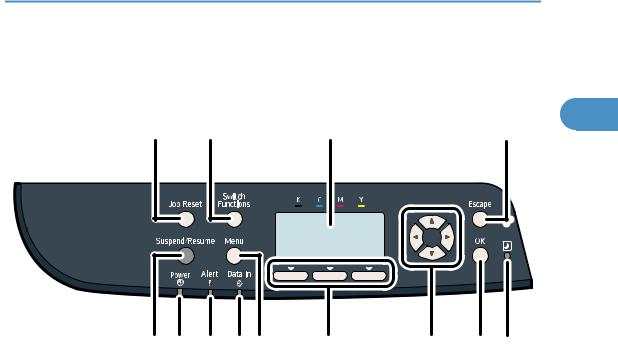
Control Panel
Control Panel
This section explains names and usage of the parts of the control panel.
1
1 |
2 |
3 |
4 |
13 |
12 |
11 |
10 |
9 |
8 |
7 |
6 |
5 |
CBK015
1.[Job Reset] Key
When the printer is online, press this key to cancel an ongoing print job.
2.[Switch Functions] Key
Press this key to switch between the operation screen of the printer function and the function screens of the extended features currently in use.
3.Display
Displays current printer status and error messages.
Entering energy saver mode turns off the back light. For details about energy saver mode, see Software Guide.
4.[Escape] Key
Press this key to cancel an operation or return to the previous display.
5.Light Sensor
Contains the light sensor used by the ECO Night Sensor function. For details about how to use this function, see "Setting the ECO Night Sensor".
6.[OK] Key
Use this key to confirm settings, or setting values, or move to the next menu level.
7.Scroll Keys
Press these keys to move the cursor in each direction.
When the [ ] [
] [ ] [
] [ ] [
] [ ] keys appear in this manual, press the scroll key of the same direction.
] keys appear in this manual, press the scroll key of the same direction.
8.Selection Keys
Correspond to the function items at the bottom line on the display.
21
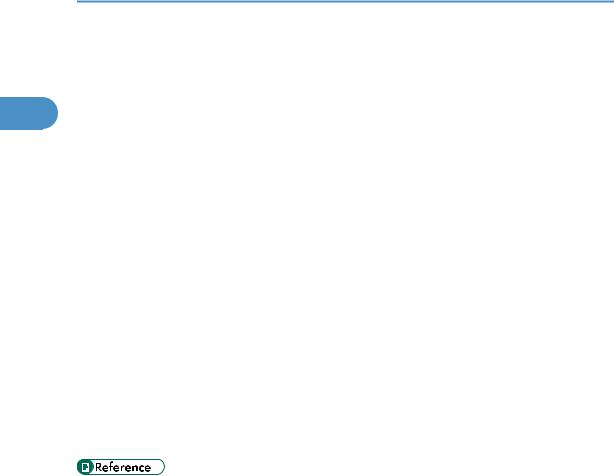
1. Guide to the Printer
Example: When this manual instructs you to press [Option], press the selection key on the left below the initial screen.
9.[Menu] Key
1Press this key to configure and check the current printer settings.
10.Data In Indicator
Flashes when the printer is receiving data from a computer. The data in indicator is lit if there is data to be printed.
11.Alert Indicator
Lights up or flashes when a printer error occurs.
Steady red: printing is not possible, or is possible but print quality cannot be ensured.
Flashing yellow: the printer will soon require maintenance or a replacement consumable such as print cartridge. Follow the instructions that appear on the display.
12.Power Indicator
Lights up when the printer is ready to receive data from a computer. Flashes when the printer is warming up or receiving data. It is unlit when the power is off or while the printer is in energy saver mode.
13.[Suspend/Resume] Key
Press this to suspend the print job currently being processed. The indicator remains lit as long as the job is suspended.
To resume the job, press this key again. Resumption of a suspended job will occur automatically when the time specified in [Auto Reset Timer] elapses (default: 60 seconds).
For details about the [Auto Reset Timer] setting, see "Making Printer Settings Using the Control Panel", Software Guide.
• p.39 "Setting the ECO Night Sensor"
22

Display Panel
Display Panel
This section explains configuration using the initial screen of the display panel.
The items are highlighted when selected. |
1 |
||||||||
|
|||||||||
|
|
|
|
|
|
|
|
|
|
|
|
|
|
|
|
|
|
|
|
• Do not touch the display panel. |
|
||||||||
The following screen appears when you turn on the printer. |
|
||||||||
1 |
|
|
|
|
|
|
|
|
|
|
|
|
|
|
|
|
|
||
|
|
|
|
|
|
|
|
||
|
|
|
|
|
|
|
|
|
|
|
|
|
|
|
|
|
|
|
|
|
|
|
|
|
|
|
|
|
|
2 |
3 |
4 |
CBK016 |
1.Operational Status or Messages
Displays the printer status or the messages.
2.[Option]
Press to display the following items:
•Form Feed
•Error Log
3.[Prt.Jobs]
Press to display print jobs sent from a computer.
4.[Supplies]
Press to display the information of supplies for the printer.
•[Prt.Jobs] is displayed only when the hard disk is installed in the printer.
•By default, the remaining amount of toner is displayed. To not display the remaining amount of toner, press the [Menu] key, and then select [Maintenance] on the display. Select [General Settings], then [Display Supply Info], and then select [Off].
•Adjust the brightness if the screen is dark. To adjust the display contrast, press the [Menu] key, and then select [Maintenance] on the display. Select [General Settings] and then [Display Contrast].
23

1. Guide to the Printer
1
24

2. Setting Up the Printer
This chapter explains how to set up and configure the printer for operation.
Printer Setup Procedure
Use the following procedure to set up the printer. |
2 |
1.Select a suitable location for your printer.
For details, see p.26 "Place to Install"
2.Take the printer out of its box, and then remove the protective materials and adhesive tape.
For details, see p.30 "Unpacking"
3.Load paper in the standard paper feed tray.
For details, see p.119 "Loading Paper in Trays"
4.Turn the printer power on.
For details, see p.36 "Turning the Printer's Power On and Off"
5.Select the language used on the display.
For details, see p.42 "Selecting the Display Language"
6.Print a test page.
For details, see p.43 "Test Printing"
7.Connect the printer to your network.
For details, see p.69 "Connecting the Printer"
8.Configure the printer's network settings.
For details, see p.79 "Configuration"
9.Install the printer driver.
For details, see Driver Installation Guide.
25
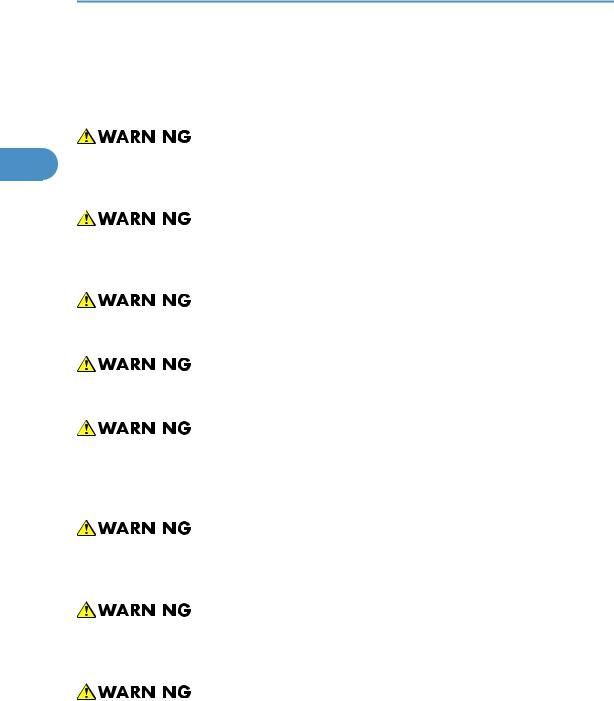
2. Setting Up the Printer
Place to Install
The printer's location should be carefully chosen because environmental conditions greatly affect its performance.
2 |
|
|
|
|
|
||
• Do not use any frequencies other than those that match the specifications shown. Doing so could |
|||
|
|||
|
result in fire or electric shock. |
||
|
|
||
|
|
||
|
|
|
|
|
|
||
|
• Do not use any power sources other than those that match the specifications shown in “Safety |
||
|
Information”. Doing so could result in fire or electric shock. |
||
|
|
||
|
|
||
|
|
|
|
|
|
||
|
• Do not use multi-socket adaptors. Doing so could result in fire or electric shock. |
||
|
|
||
|
|
||
|
|
|
|
|
|
||
|
• Do not use extension cords. Doing so could result in fire or electric shock. |
||
|
|
||
|
|
||
|
|
|
|
|
|
||
|
• Do not use power cords that are damaged, broken, or modified. Also, do not use power cords |
||
|
that have been trapped under heavy objects, pulled hard, or bent severely. Doing so could result |
||
|
in fire or electric shock. |
||
|
|
||
|
|
||
|
|
|
|
|
|
||
|
• Touching the prongs of the power cable's plug with anything metallic constitutes a fire and electric |
||
|
shock hazard. |
||
|
|
||
|
|
||
|
|
|
|
|
|
||
|
• The supplied power cord is for use with this machine only. Do not use it with other appliances. |
||
|
Doing so could result in fire, electric shock, or injury. |
||
|
|
||
|
|
||
|
|
|
|
|
|
||
|
• It is dangerous to handle the power cord plug with wet hands. Doing so could result in electric |
||
|
shock. |
||
|
|
|
|
26

Place to Install
•If the power cord is damaged and its inner wires are exposed or broken, contact your service representative for a replacement. Use of damaged power cords could result in fire or electric shock.
|
|
2 |
|
|
|
• Be sure to locate the machine as close as possible to a wall outlet. This will allow easy disconnection |
||
of the power cord in the event of an emergency. |
|
|
|
|
|
|
|
|
|
|
|
•Do not use flammable sprays or solvents in the vicinity of this machine. Doing so could result in fire or electric shock.
•Keep the machine away from humidity and dust. Otherwise a fire or an electric shock might occur.
•Do not place the machine on an unstable or tilted surface. If it topples over, an injury might occur.
•Make sure the room where you are using the machine is well ventilated and spacious. Good ventilation is especially important when the machine is used heavily.
•Be sure to disconnect the plug from the wall outlet and clean the prongs and the area around the prongs at least once a year. Allowing dust to build up on the plug constitutes a fire hazard.
•Machine sound levels exceeding [Sound Power Level (Black and White)] > 63 dB (A) are not suitable for desk work environments, so place the machine in another room.
•When new, electrical devices containing volatile materials will normally release emissions into the air of their vicinity. For this reason, for the first few days after installation of a new device, strong ventilation inside the room where it is placed is necessary.
Space Required for Installation
The recommended (or minimum) space requirements are as follows:
27
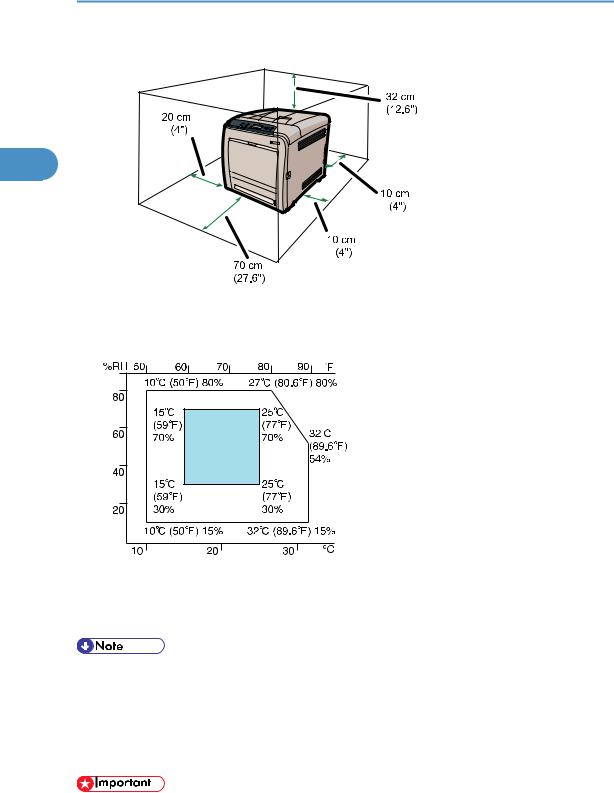
2. Setting Up the Printer
2
CBK018
Optimum Environmental Conditions
Permissible and recommended temperature and humidity ranges are as follows:
CBK019 |
•White area: Permissible Range
•Blue area: Recommended Range
•The printer must be level within 3 mm, 0.2" from both front to rear and left to right.
•When you use this printer for a long time in a confined space without good ventilation, you may detect an odd smell. To keep the workplace comfortable, we recommend you keep it well ventilated.
Environments to Avoid
Do not use the printer in the following environments:
• Areas exposed to direct sunlight or strong light
28
